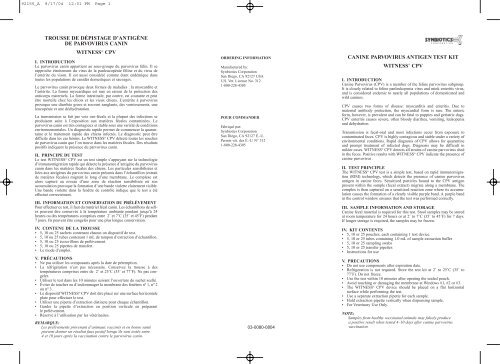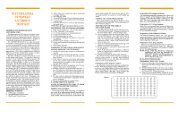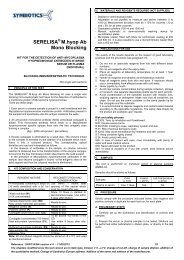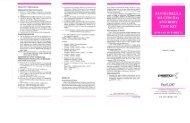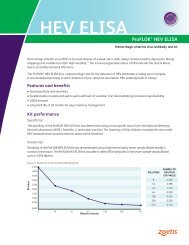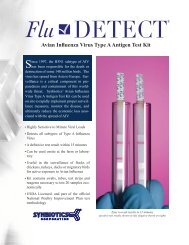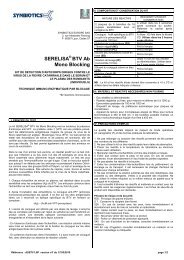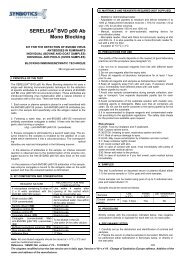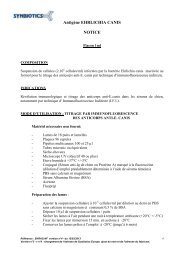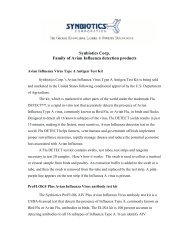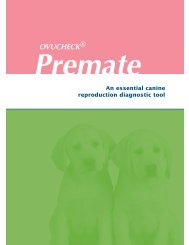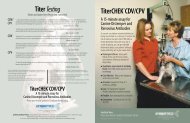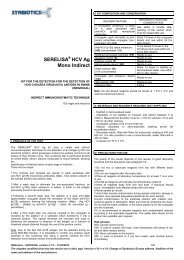canine parvovirus antigen test kit witness® cpv trousse de dépistage ...
canine parvovirus antigen test kit witness® cpv trousse de dépistage ...
canine parvovirus antigen test kit witness® cpv trousse de dépistage ...
You also want an ePaper? Increase the reach of your titles
YUMPU automatically turns print PDFs into web optimized ePapers that Google loves.
92155_A 8/17/04 12:01 PM Page 1<br />
TROUSSE DE DÉPISTAGE D’ANTIGÈNE<br />
DE PARVOVIRUS CANIN<br />
WITNESS ® CPV<br />
I. INTRODUCTION<br />
Le <strong>parvovirus</strong> canin appartient au sous-groupe du <strong>parvovirus</strong> félin. Il se<br />
rapproche étroitement du virus <strong>de</strong> la panleucopénie féline et du virus <strong>de</strong><br />
l’entérite du vison. Il est aussi considéré comme étant endémique dans<br />
toutes les populations <strong>de</strong> canidés domestiques et sauvages.<br />
Le <strong>parvovirus</strong> canin provoque <strong>de</strong>ux formes <strong>de</strong> maladies : la myocardite et<br />
l’entérite. La forme myocardique est rare en raison <strong>de</strong> la protection <strong>de</strong>s<br />
anticorps maternels. La forme in<strong>test</strong>inale, par contre, est courante et peut<br />
être mortelle chez les chiots et les vieux chiens. L’entérite à <strong>parvovirus</strong><br />
provoque une diarrhée grave et souvent sanglante, <strong>de</strong>s vomissements, une<br />
leucopénie et une déshydratation.<br />
La transmission se fait par voie oro-fécale et la plupart <strong>de</strong>s infections se<br />
produisent suite à l’exposition aux matières fécales contaminées. Le<br />
<strong>parvovirus</strong> canin est très contagieux et stable sous une variété <strong>de</strong> conditions<br />
environnementales. Un diagnostic rapi<strong>de</strong> permet <strong>de</strong> commencer la quarantaine<br />
et le traitement rapi<strong>de</strong> <strong>de</strong>s chiens infectés. Le diagnostic peut être<br />
difficile dans les cas bénins. Le WITNESS ® CPV détecte toutes les souches<br />
<strong>de</strong> <strong>parvovirus</strong> canin que l’on trouve dans les matières fécales. Des résultats<br />
positifs indiquent la présence du <strong>parvovirus</strong> canin.<br />
II. PRINCIPE DU TEST<br />
Le <strong>test</strong> WITNESS ® CPV est un <strong>test</strong> simple s’appuyant sur la technologie<br />
d’immunomigration rapi<strong>de</strong> qui détecte la présence d’antigène du <strong>parvovirus</strong><br />
canin dans les matières fécales <strong>de</strong>s chiens. Les particules sensibilisées et<br />
liées aux antigènes du <strong>parvovirus</strong> canin présents dans l’échantillon (extrait<br />
<strong>de</strong> matières fécales) migrent le long d’une membrane. Le complexe est<br />
alors capturé au niveau d’une zone <strong>de</strong> réaction sensibilisée où son<br />
accumulation provoque la formation d’une ban<strong>de</strong> violette clairement visible.<br />
Une ban<strong>de</strong> violette dans la fenêtre <strong>de</strong> contrôle indique que le <strong>test</strong> a été<br />
effectué correctement.<br />
III. INFORMATION ET CONSERVATION DU PRÉLÈVEMENT<br />
Pour effectuer ce <strong>test</strong>, il faut du matériel fécal canin. Les échantillons <strong>de</strong> selles<br />
peuvent être conservés à la température ambiante pendant jusqu’à 24<br />
heures ou <strong>de</strong>s températures comprises entre 2˚ et 7˚C (35˚ et 45˚F) pendant<br />
7 jours. Ils peuvent être congelés pour une plus longue conservation.<br />
IV. CONTENU DE LA TROUSSE<br />
• 5, 10 ou 25 sachets contenant chacun un dispositif <strong>de</strong> <strong>test</strong>.<br />
• 5, 10 ou 25 tubes contenant 1 mL <strong>de</strong> tampon d’extraction d’échantillon.<br />
• 5, 10 ou 25 écouvillons <strong>de</strong> prélèvement.<br />
• 5, 10 ou 25 pipettes <strong>de</strong> transfert.<br />
• Le mo<strong>de</strong> d’emploi.<br />
V. PRÉCAUTIONS<br />
• Ne pas utiliser les composants après la date <strong>de</strong> péremption.<br />
• La réfrigération n’est pas nécessaire. Conservez la <strong>trousse</strong> à <strong>de</strong>s<br />
températures comprises entre <strong>de</strong> 2˚ et 25˚C (35˚ et 77˚F). Ne pas congeler.<br />
• Utiliser le <strong>test</strong> dans les 10 minutes suivant l’ouverture du sachet scellé.<br />
• Éviter <strong>de</strong> toucher ou d’endommager la membrane <strong>de</strong>s fenêtres nº 1, nº 2<br />
ou nº 3.<br />
• Le dispositif WITNESS ® CPV doit être placé sur une surface horizontale<br />
plate pour effectuer le <strong>test</strong>.<br />
• Utiliser une pipette d’extraction distincte pour chaque échantillon.<br />
• Gar<strong>de</strong>r la pipette d’extraction en position verticale en préparant<br />
le prélèvement.<br />
• Réservé à l’utilisation par les vétérinaires.<br />
REMARQUE:<br />
Les prélèvements provenant d’animaux vaccinés et en bonne santé<br />
peuvent donner un résultat faux positif lorsqu’ils sont <strong>test</strong>és entre<br />
4 et 10 jours après la vaccination contre le <strong>parvovirus</strong> canin.<br />
ORDERING INFORMATION<br />
Manufactured by:<br />
Synbiotics Corporation<br />
San Diego, CA 92127 USA<br />
U.S. Vet. License No. 312<br />
1-800-228-4305<br />
POUR COMMANDER<br />
Fabriqué par:<br />
Synbiotics Corporation<br />
San Diego, CA 92127 É.-U.<br />
Permis vét. <strong>de</strong>s É.-U. N° 312<br />
1-800-228-4305<br />
03-0080-0804<br />
CANINE PARVOVIRUS ANTIGEN TEST KIT<br />
WITNESS ® CPV<br />
C O R P O R A T I O N<br />
I. INTRODUCTION<br />
Canine Parvovirus (CPV) is a member of the feline <strong>parvovirus</strong> subgroup.<br />
It is closely related to feline panleukopenia virus and mink enteritis virus,<br />
and is consi<strong>de</strong>red en<strong>de</strong>mic to nearly all populations of domesticated and<br />
wild <strong>canine</strong>s.<br />
CPV causes two forms of disease: myocarditis and enteritis. Due to<br />
maternal antibody protection, the myocardial form is rare. The enteric<br />
form, however, is prevalent and can be fatal to puppies and geriatric dogs.<br />
CPV enteritis causes severe, often bloody diarrhea, vomiting, leukopenia<br />
and <strong>de</strong>hydration.<br />
Transmission is fecal-oral and most infections occur from exposure to<br />
contaminated feces. CPV is highly contagious and stable un<strong>de</strong>r a variety of<br />
environmental conditions. Rapid diagnosis of CPV allows for quarantine<br />
and prompt treatment of infected dogs. Diagnosis may be difficult in<br />
mil<strong>de</strong>r cases. WITNESS ® CPV <strong>de</strong>tects all strains of <strong>canine</strong> <strong>parvovirus</strong> shed<br />
in the feces. Positive results with WITNESS ® CPV indicate the presence of<br />
<strong>canine</strong> <strong>parvovirus</strong> .<br />
II. TEST PRINCIPLE<br />
The WITNESS ® CPV <strong>test</strong> is a simple <strong>test</strong>, based on rapid immunomigration<br />
(RIM) technology, which <strong>de</strong>tects the presence of <strong>canine</strong> <strong>parvovirus</strong><br />
<strong>antigen</strong> in <strong>canine</strong> feces. Sensitized particles bound to the CPV <strong>antigen</strong><br />
present within the sample (fecal extract) migrate along a membrane. The<br />
complex is then captured on a sensitized reaction zone where its accumulation<br />
causes the formation of a clearly visible purple band. A purple band<br />
in the control window ensures that the <strong>test</strong> was performed correctly.<br />
III. SAMPLE INFORMATION AND STORAGE<br />
Canine fecal material is required for this <strong>test</strong>. Stool samples may be stored<br />
at room temperature for 24 hours or at 2˚ to 7˚C (35˚ to 45˚F) for 7 days.<br />
If longer storage is required, the samples may be frozen.<br />
IV. KIT CONTENTS<br />
• 5, 10 or 25 pouches, each containing 1 <strong>test</strong> <strong>de</strong>vice.<br />
• 5, 10 or 25 tubes containing 1.0 mL of sample extraction buffer<br />
• 5, 10 or 25 sampling swabs<br />
• 5, 10 or 25 transfer pipettes<br />
• Instructions for use<br />
V. PRECAUTIONS<br />
• Do not use components after expiration date.<br />
• Refrigeration is not required. Store the <strong>test</strong> <strong>kit</strong> at 2˚ to 25˚C (35˚ to<br />
77˚F). Do not freeze.<br />
• Use the <strong>test</strong> within 10 minutes after opening the sealed pouch.<br />
• Avoid touching or damaging the membrane at Windows #1, #2 or #3.<br />
• The WITNESS ® CPV <strong>de</strong>vice should be placed on a flat horizontal<br />
surface while performing the <strong>test</strong>.<br />
• Use a separate extraction pipette for each sample.<br />
• Hold extraction pipette vertically when dispensing sample.<br />
• For Veterinary Use Only.<br />
NOTE:<br />
Samples from healthy vaccinated animals may falsely produce<br />
a positive result when <strong>test</strong>ed 4–10 days after <strong>canine</strong> <strong>parvovirus</strong><br />
vaccination.<br />
®
92155_A 8/17/04 12:01 PM Page 2<br />
VI. TEST PROCEDURE AND RESULTS<br />
1. SAMPLE EXTRACTION:<br />
• For each sample to be <strong>test</strong>ed, you will need one sampling swab and one<br />
tube of pre-dispensed sample extraction buffer. Remove the stopper<br />
from the tube. Coat the swab with a thin layer of feces.<br />
• Immerse the feces coated swab into the sample extraction buffer in the<br />
tube. Swirl the swab in the buffer. Remove as much fecal material from<br />
the swab as possible by swirling vigorously and pressing the swab<br />
against the si<strong>de</strong> of the tube.<br />
• When removing the swab from the <strong>test</strong> tube, press the swab against the<br />
si<strong>de</strong> of the tube repeatedly until no more liquid comes from the swab.<br />
• Completely remove the swab from the tube and discard appropriately.<br />
2. SAMPLE APPLICATION:<br />
• For each sample to be <strong>test</strong>ed, you will need one <strong>de</strong>vice, one pipette and<br />
the tube of extracted sample.<br />
• Prepare the <strong>de</strong>vice by tearing open the pouch and placing the <strong>test</strong> <strong>de</strong>vice<br />
on a flat horizontal surface for the duration of the <strong>test</strong>.<br />
• Squeeze the pipette near the sealed end. Immerse the open end of the<br />
pipette into the extracted fecal solution. Release the pressure slightly to<br />
draw up a small amount of sample into the pipette.<br />
• Holding the pipette vertically, transfer three drops of sample to the<br />
sample well, Window #1. Allow sample drops to fall onto membrane at<br />
Window #1. Do not touch pipette tip directly to the membrane.<br />
• If migration does not pass Window #2 by one minute, add one<br />
additional drop of sample.<br />
3. READING TEST:<br />
• Wait ten minutes, observe the presence or absence of pink/purple bands<br />
in Windows #2 and #3.<br />
• Sample results are read in Window #2. The control band is read in<br />
Window #3.<br />
NOTES:<br />
The <strong>test</strong> is complete and may be read before 10 minutes if pink/purple<br />
bands are visible in both Windows #2 and #3. The presence of a<br />
pink/purple band only in Window #3 does NOT mean that the <strong>test</strong> is<br />
complete as a band in Window #2 may <strong>de</strong>velop slower than the<br />
control band in Window #3. Wait a full 10 minutes before <strong>de</strong>claring<br />
a result as negative.<br />
4. RESULTS:<br />
Validation: Test is validated if a pink/purple band is present in Window #3.<br />
Interpretation:<br />
• Negative for <strong>canine</strong> <strong>parvovirus</strong> (CPV) <strong>antigen</strong>: No band in Window #2,<br />
with one pink/purple band in Window #3.<br />
• Positive for CPV <strong>antigen</strong>: One pink/purple band in Window #2, with one<br />
pink/purple band in Window #3.<br />
• Samples with low levels of CPV <strong>antigen</strong> may produce a lighter colored<br />
yet distinct pink/purple band.<br />
Invalid <strong>test</strong>: No pink/purple band in Window #3.<br />
NOTE:<br />
A <strong>test</strong> result should always be interpreted in the context of all available<br />
clinical information and history for the dog. If clinical signs<br />
warrant, it is recommen<strong>de</strong>d to re<strong>test</strong> using a fresh sample.<br />
WITNESS ® CPV TEST PROCEDURE<br />
PROCÉDURE DU TEST<br />
1.a<br />
swirl vigorously<br />
remuer vigoureusement<br />
2.<br />
CPV<br />
CPV<br />
3<br />
Wait 10 minutes. a maximum of<br />
Atten<strong>de</strong>z maximum. 10 minutes<br />
1.b<br />
Read results. Lisez les résultats.<br />
Add sample 3 drops of<br />
Ajoutez d’échantillon 3 gouttes<br />
10'(max.)<br />
Invalid results. Résultats non vali<strong>de</strong>s.<br />
0<br />
VI. PROCÉDURE DU TEST ET RÉSULTATS<br />
1. Prélèvement d’échantillon:<br />
• Pour chaque prélèvement à <strong>test</strong>er, vous aurez besoin d’un écouvillon <strong>de</strong><br />
prélèvement et d’un tube <strong>de</strong> tampon d’extraction <strong>de</strong> prélèvement.<br />
Retirez l’obturateur du tube. Saturez l’écouvillon d’une mince couche<br />
<strong>de</strong> matières fécales.<br />
• Plongez l’écouvillon recouvert <strong>de</strong> matières fécales dans le tampon<br />
d’extraction <strong>de</strong> prélèvement qui se trouve dans le tube. Tournez<br />
l’écouvillon dans le tampon. Libérer autant <strong>de</strong> matières fécales que<br />
possible <strong>de</strong> l’écouvillon en tournant vigoureusement et en le pressant<br />
contre la paroi du tube.<br />
• Lorsque vous retirez l’écouvillon du tube, pressez-le plusieurs fois<br />
contre la paroi du tube jusqu’à ce qu’il n’y ait plus <strong>de</strong> liqui<strong>de</strong> qui en sorte.<br />
• Retirez entièrement l’écouvillon du tube et jetez adéquatemant.<br />
2. Application <strong>de</strong> prélèvement:<br />
• Pour chaque prélèvement à <strong>test</strong>er, vous aurez besoin d’un dispositif,<br />
d’une pipette et d’un tube d’extrait du prélèvement.<br />
• Préparez le dispositif en déchirant le sachet et en plaçant le dispositif <strong>de</strong><br />
<strong>test</strong> sur une surface horizontale.<br />
• Pressez la pipette près <strong>de</strong> l’extrémité scellée. Plongez l’extrémité<br />
ouverte <strong>de</strong> la pipette dans la solution fécale extraite. Dégagez un peu la<br />
pression pour retirer une petite quantité <strong>de</strong> prélèvement dans la pipette.<br />
• Tenez la pipette verticalement et transférez trois gouttes d’échantillon<br />
dans le puits <strong>de</strong> prélèvement <strong>de</strong> la fenêtre nº 1. Laisser tomber les<br />
gouttes d’échantillon sur la membrane <strong>de</strong> la fenêtre nº 1. Ne pas mettre<br />
le bout <strong>de</strong> la pipette, ni les gouttes d’échantillon directement en contact<br />
avec la membrane <strong>de</strong> la fenêtre nº 1.<br />
• Si le liqui<strong>de</strong> ne passe pas la fenêtre nº 2 dans la minute qui suit, ajouter<br />
une autre goutte d’échantillon.<br />
3. Lecture du <strong>test</strong>:<br />
• Atten<strong>de</strong>z dix minutes, observez la présence ou l’absence <strong>de</strong> ban<strong>de</strong>s<br />
roses/violettes dans les fenêtres nº 2 et nº 3.<br />
• Lisez les résultats du prélèvement dans la fenêtre nº 2. La ban<strong>de</strong> <strong>de</strong><br />
contrôle se lit dans la fenêtre nº 3.<br />
REMARQUES:<br />
• Le <strong>test</strong> est terminé et vous pouvez le lire avant la fin <strong>de</strong>s 10 minutes si<br />
les ban<strong>de</strong>s roses/violettes sont visibles dans les fenêtres nº 2 et nº 3. S’il<br />
n’y a qu’une ban<strong>de</strong> rose/violette dans la fenêtre nº 3, cela NE signifie<br />
PAS que le <strong>test</strong> est terminé car une ban<strong>de</strong> dans la fenêtre nº 2 peut apparaître<br />
plus lentement que la ban<strong>de</strong> <strong>de</strong> contrôle <strong>de</strong> la fenêtre nº 3.<br />
Atten<strong>de</strong>z que 10 minutes soient écoulées avant <strong>de</strong> déclarer un résultat<br />
négatif.<br />
4. RÉSULTATS:<br />
Validation:<br />
Le <strong>test</strong> est validé s’il y a une ban<strong>de</strong> rose/violette dans la fenêtre nº 3.<br />
Interprétation:<br />
• Négatif pour antigène du <strong>parvovirus</strong> canin: aucune ban<strong>de</strong> dans la fenêtre<br />
nº 2 et une ban<strong>de</strong> rose/violette dans la fenêtre nº 3.<br />
• Positif pour antigène du <strong>parvovirus</strong> canin: une ban<strong>de</strong> rose/violette dans<br />
la fenêtre nº 2, avec une ban<strong>de</strong> rose/violette dans la fenêtre nº 3.<br />
• Les échantillons avec les niveaux bas <strong>de</strong> l’antigène <strong>de</strong> CPV peuvent<br />
produire une ban<strong>de</strong> colorée pourtant distincte d’allumeur <strong>de</strong> rose/violette.<br />
Test non vali<strong>de</strong>:<br />
Test non vali<strong>de</strong>: Aucune ban<strong>de</strong> rose/violette dans la fenêtre nº 3.<br />
REMARQUE:<br />
Un résultat <strong>de</strong> <strong>test</strong> doit toujours être interprété en tenant compte<br />
<strong>de</strong> toutes les informations cliniques disponibles et <strong>de</strong>s antécé<strong>de</strong>nts<br />
du chien. Si clinique garantie <strong>de</strong> signes, on lui recomman<strong>de</strong> d’essayer<br />
<strong>de</strong> nouveau en utilisant un échantillon frais.


